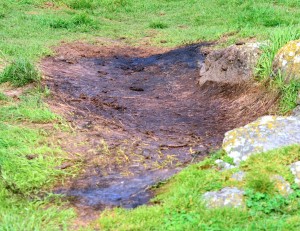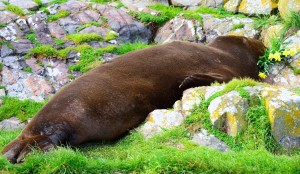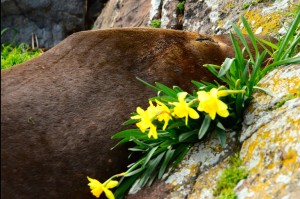Last night’s north easterlies created a bit of a symphony: percussion on soffits accompanied by back door whistling its multifarious tunes. Morning started with the call of Canada Geese arriving, southerly winds (10 – 15 knots) and rainy skies. By late morning the wind direction had changed to west and the sky eventually cleared to a mix of sun and cloud by late afternoon. The gentle to moderate westerly is forecast to continue tomorrow bringing a 30% chance of showers. The barometer has been rising all day, so things are looking up.
‘Sports’ fishers were seen passing and fishing in the distance today and there were no sightings of whale watchers in the Ecological Reserve.
I went out to clear off the geese first thing and saw a pair mating in the water. That inspired me to ramp up daily goose patrols. No sign of nests yet, but there are a few pairs that are hormonally persistent. The large number of Bald Eagles is potentially helping keep the geese nervous. I saw an adult eagle flying with some sort of large bird, hanging from its talons but could not tell if it was a goose or a cormorant. The gulls seem to be setting up their territories, even though it still seems quite early for anything very serious. Pigeon Guillemots, Glaucous-winged gulls, and Black Oystercatchers are all in breeding plumage, as are many of the three species of cormorant.
Chunk actually moved today, leaving his dead, stink zone for fresh flowers and a sloped recline on the other side of the paths. I also saw him open one eye as I walked past, a small feat of energetic response. He really is wiped out from all of his male activities.
A California Sea Lion, which is equally lethargic, is hauled out beside the derrick and he looks quite emaciated with backbones and ribs showing. The rest of Sea Lions that remain look healthy and haul out tightly together in two spots, a small group just down to the northwest of the Science House and a larger group on the South Islets. There are a few branded animals but I haven’t been able to get photos yet. A male Steller’s 76Y (left side) and a couple of rump branded Columbian California Sea Lions. 76Y was branded at St. George Reef in northern California, just south of Oregon, in 2002 as a pup. 443Y is just going into its third year and was branded at Rogue Reef in southern Oregon, just north of the California border, in 2013.
- Not exactly a snow angel more of a dead spot that outlines where Chunk has been lying for the last week.
- In a new, fresh spot, Chunk reclines amongst the daffodils.
- Sound asleep and surrounded by daffs, I hope he is dreaming of deep sea pursuits.
There were no visitors and chores were routine.


